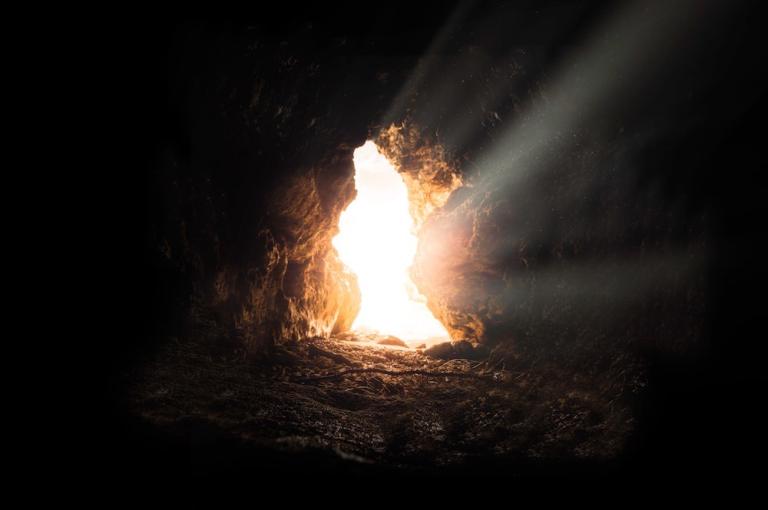
What actually happened on the Sunday after Jesus’s death? Just the day before, the body of a crucified Jesus lays in a tomb in a cave, but by the next day he has mysteriously disappeared. Had he gone to heaven to be “seated with God”? Or did he, for at least a short time, remain here on Earth?
As it turns out, there is not one story but many stories about what happened after the death of Jesus. One you might know is the curious passage known as “the road to Emmaus” that appears in the Gospel of Luke. Two disciples meet a man while travelling and spend several hours with him, telling the man about Jesus. They invite him to dinner at which point, they, shockingly, recognize him as Jesus.
When he was at the table with them, he took bread, gave thanks, broke it and began to give it to them. Then their eyes were opened and they recognized him, and he disappeared from their sight. ~Luke 24:30-31
But perhaps the best place to look for the true resurrection story is with the oldest gospel, Mark. Most historians believe it pre-dates the other gospels by as many as a few decades. There’s just one issue with Mark. Researchers at the Biblical Archaeology Society (BAS) have uncovered “a variety” of stories about the resurrection among the 1,700 surviving ancient manuscripts and early translations of the gospel.
Let’s start with the oldest, original version of the story as it appears in Mark 16:1-8:
When the sabbath was over, Mary Magdalene, and Mary the mother of James, and Salome bought spices, so that they might go and anoint him. And very early on the first day of the week, when the sun had risen, they went to the tomb. They had been saying to one another, “Who will roll away the stone for us from the entrance to the tomb?” When they looked up, they saw that the stone, which was very large, had already been rolled back.
As they entered the tomb, they saw a young man, dressed in a white robe, sitting on the right side; and they were alarmed. But he said to them, “Do not be alarmed; you are looking for Jesus of Nazareth, who was crucified. He has been raised; he is not here. Look, there is the place they laid him. But go, tell his disciples and Peter that he is going ahead of you to Galilee; there you will see him, just as he told you.”
And going out they fled from the tomb, for terror and amazement had seized them; and they said nothing to anyone, for they were afraid.
That’s it, literally the end of the story—and not the happiest of endings. As biblical scholar Elaine Pagels points out:
No angel appears, no miracle intervenes. Instead, after telling how Roman soldiers crucified Jesus, this story ends with an abrupt, disturbing scene at the grave site, in which Jesus’s women followers, having come to tend to his body, find it missing.
Where had Jesus gone? Had he descended bodily to heaven? What about the promise to appear to Peter and the disciples in Galilee? It was something that many early Christians felt needed to be addressed. James Tabor of the BAS reports that:
This original ending of Mark was viewed by later Christians as so deficient that not only was Mark placed second in order in the New Testament, but various endings were added by editors and copyists in some manuscripts to try to remedy things.
My go-to Holy Bible, a Contemporary English Version published by the American Bible Society, tacks on 2 alternate endings after the original passage above. But Tabor informs us that there are a total of 9 alternate endings to Mark. In most, the resurrected Jesus shows himself to others. This includes the disciples on the road, Mary Magdalene, and/or 11 disciples in Jerusalem.
Is it possible to find meaning in the original ending of Mark?
Elaine Pagels says yes. To put this in context, in her book Why Religion? Pagels recounts the period when her husband died suddenly at the age of 49 in a hiking accident. She is devastated. She begins re-reading the Bible after his death, searching for meaning. When it comes to Mark’s original ending to the resurrection story, she realizes:
Troubling as other’s found Mark’s original version, I preferred it. What he wrote sounded more like the world in which we live.
You may see where she’s coming from. How does one make sense of the sudden death of someone so cherished, in her case her husband? Likewise, how were the early followers of Jesus to find meaning in his sudden and terrible death?
Pagels comes to understand “how to hold on to hope when confronting what looks like disaster.” From her point of view, Mark’s story “doesn’t end with death.” Jesus had prophesized that “God’s victory is coming soon.” But it is happening beyond the frame of the original Mark narrative. The story is “not about failure, but unfinished victory.”
The story of the resurrection is really about hope–not just for today, but for the future. As Richard Rohr wrote:
I like to think of the resurrection as God’s way of telling us that God can take the worst thing in the world—the killing of the God-Human Jesus—and change it into the best thing: the redemption of the world.
For a related column, see The Secret Story Behind the Resurrection of Jesus













